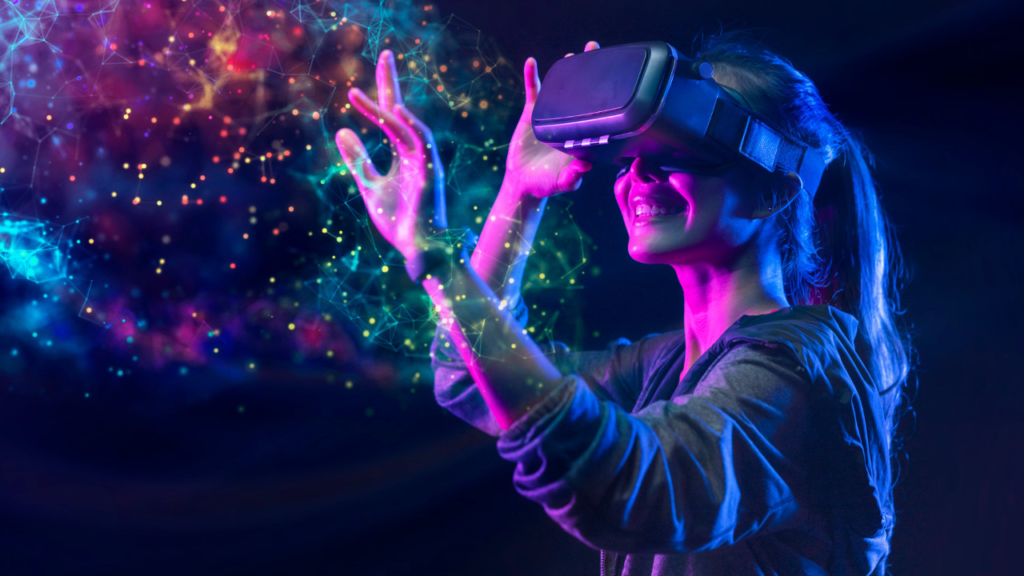Virtual reality (VR), along with augmented (AR) and mixed reality (MR), is transforming sectors by providing immersive digital experiences.
This article explores the tips and challenges of developing for VR while integrating AR, VR, and MR as the main keywords.
Understanding AR, VR, and MR
Augmented Reality (AR)

AR enriches the actual environment by superimposing digital information on physical items. It uses smartphones or AR glasses to project virtual items into the user’s field of view. Common uses include interactive maps and game experiences such as Pokémon GO.
Virtual Reality (VR)

VR produces totally virtual settings, providing immersive experiences via headgear such as the Oculus Rift and HTC Vive. Users may explore and interact with these worlds which are frequently used for gaming, training simulations, and virtual tours.
Mixed Reality (MR)

MR integrates the actual and virtual worlds, allowing digital and physical elements to interact in real time. This technology is more complex and often requires expensive gear, such as the Microsoft HoloLens. MR is utilized in design, teaching, and remote collaboration.
Tips for Developing VR Applications
1. Focus on User Experience
User experience is crucial in VR development. Ensure intuitive controls and smooth navigation to prevent user frustration and motion sickness. Use visual and audio cues to guide users and enhance immersion.
2. Optimize Performance
VR applications require high performance to deliver seamless experiences. Optimize graphics and reduce latency to maintain high frame rates. Consider the hardware limitations of your target audience and test on various devices.
3. Design for Comfort
Comfort is essential in VR. Avoid sudden movements or disorienting transitions. Design environments with ample space and provide options for users to adjust settings based on their comfort levels.
4. Utilize AR and MR Elements
Incorporate AR and MR elements to enhance your VR application. AR can add real-world context, while MR can create interactive experiences that blend physical and virtual worlds. This integration can make your application more versatile and engaging.
5. Prioritize Accessibility
Make your VR application accessible to a broader audience. Implement features like subtitles, alternative control schemes, and customizable settings. This ensures that users with different needs can enjoy your application.
Challenges in VR Development
1. Technical Limitations
VR development is often limited by hardware capabilities. High-quality VR experiences require powerful processors, advanced graphics, and precise tracking systems. Developers must balance performance and quality to cater to various devices.
2. Motion Sickness
Motion sickness is a common issue in VR. It occurs when there is a disconnect between visual input and physical movement. To mitigate this, developers need to design smooth and predictable motion and provide options for users to adjust sensitivity.
3. Content Creation
Creating content for VR is more complex than traditional media. It involves 3D modeling, spatial audio, and interactive design. Developers need specialized skills and tools to produce high-quality VR content.
4. User Interaction
Designing intuitive and natural user interactions in VR is challenging. Developers must consider new input methods like hand tracking, eye tracking, and voice commands. Ensuring these interactions feel natural and responsive requires thorough testing and iteration.
5. Market Fragmentation
The VR market is fragmented, with various platforms and devices. Developing for multiple platforms can be time-consuming and costly. Developers need to decide whether to focus on a single platform or invest in cross-platform compatibility.
Conclusion
Developing for VR, with the integration of AR and MR elements, presents exciting opportunities and significant challenges. By focusing on user experience, optimizing performance, designing for comfort, utilizing AR and MR, and prioritizing accessibility, developers can create compelling VR applications.
However, they must also navigate technical limitations, motion sickness, content creation complexities, user interaction design, and market fragmentation. Embracing these tips and overcoming these challenges will enable developers to deliver immersive and engaging VR experiences.
Integrating AR, VR, and MR is the future of digital interaction, offering endless possibilities for innovation and creativity.
[…] Market & Trend: Virtual Reality (VR) and Augmented Reality (AR) […]